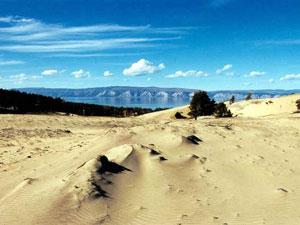Baikal highlights
go back to the region description
Highlights of Baikal:
- Olkhon Island
- Thermal springs
- Russian architecture monuments in Irkutsk
- Open-air Museum of wooden architecture in Talzy
- Ivolginsky Datsan
- Remains from the ancient civilizations
- "Baikal railroad"
- Khoboy Crag
In Detail:
- The geographical and historical centre of Lake Baikal is the Olkhon island. It is the largest of the 30 islands on the lake (77 km long) and a reserve of breathtaking scenery: sandy beaches, taiga forest, steppe bounded by orange cliffs. The channel between this island and the mainland is one of the few places at Baikal where water is warm enough for swimming in summer.
- Thermal springs in the north and south of Baikal.
- The wooden and stone Russian architecture monuments in Irkutsk, including historic Orthodox churches.
- The open-air Museum of wooden architecture in Talzy which is located in a picturesque forest on the bank of Angara river, 47 km from Irkutsk and 23 km from Lake Baikal. It represents settlements of the local Baikal people - Evenks, Russians, Buryats - and gives an overview of the traditional life style in Siberia in the 17-19th centuries.
- Ivolginsky Datsan is the Buddhist centre of Russia. Its well-preserved temple is among the best historical samples of Buddhist architecture in Russia.
- Remains from the ancient civilizations: graves, old settlements, ancient stone carvings, ruins of stone walls and monuments which are several thousand years old.
- The old “Baikal railroad” - a unique memorial to engineering art from the beginning of the 20th century, which all 39 tunnels were built without machines. The rail goes through the rocks along the Southern shore of Baikal. It is called “the golden buckle of the Transsib’s steel belt of Russia”.
- Khoboy Crag is located opposite the widest part of Baikal (79,8 km). There’s a special site (a small platform) that was used for meditation and performing “tailagans” – gatherings of shamans. From the cape one can often see Baikal nerpas –the world’s only fresh-water seals and the lake’s only aquatic animals.
Other info:
- Size: The “well of the earth” contains one fifth of the world surface fresh water and would be sufficient to provide the earth's population with fresh water for 50 years. Should the water in the lake run out, the whole land surface of our planet would be flooded more than up to 20 cm.
- Future ocean: The lake is so huge and enormous that the locals call it a sea. This “sea” is growing at an average speed of 2cm per year.
- “Paris of Siberia”: The city of Irkutsk was founded by Russians in 1661 - at the beginning of the colonization of Siberia and was a political, economical and cultural center of Siberia since that time. In the 19th century Irkutsk became a settlement for the exiled families of the “Decembrists” – liberal Russian aristocrats who dared to rebel against the monarchy in December 1825 and were exiled to Siberia. The presence of that noble community in Irkutsk during the 19th century significantly influenced the culture and architecture of the city.
- In 1996, lake Baikal was added to UNESCO World Heritage List.
